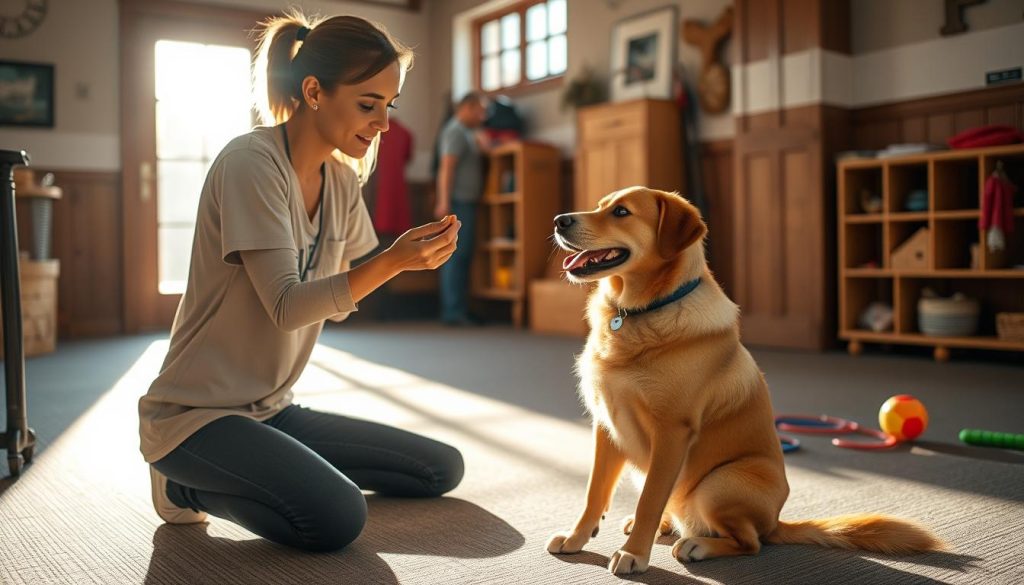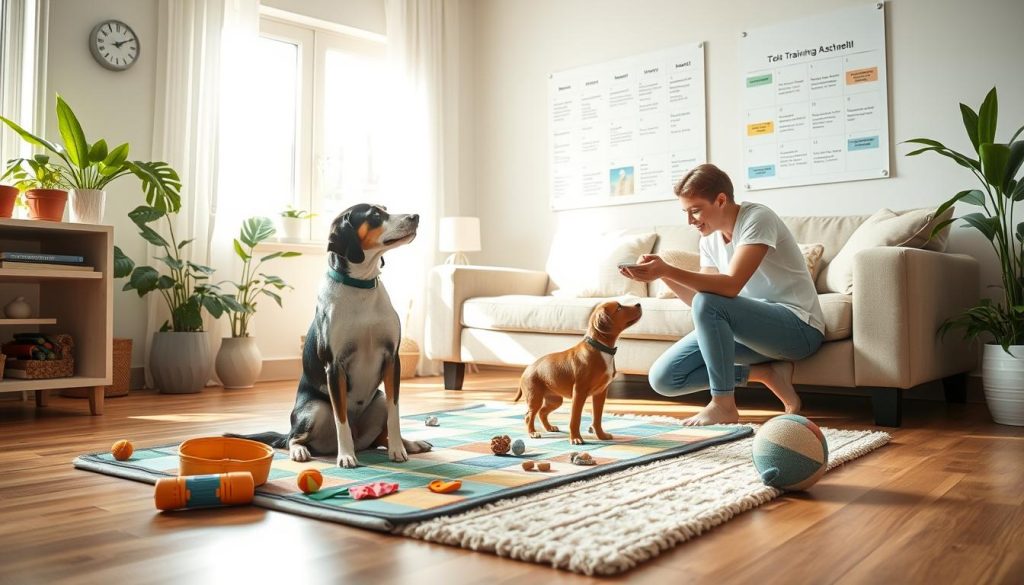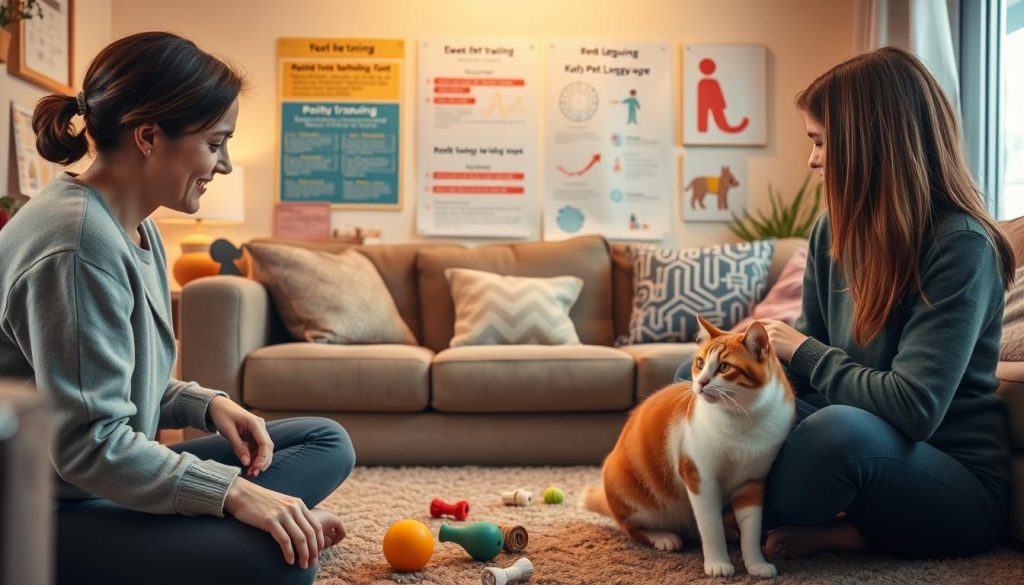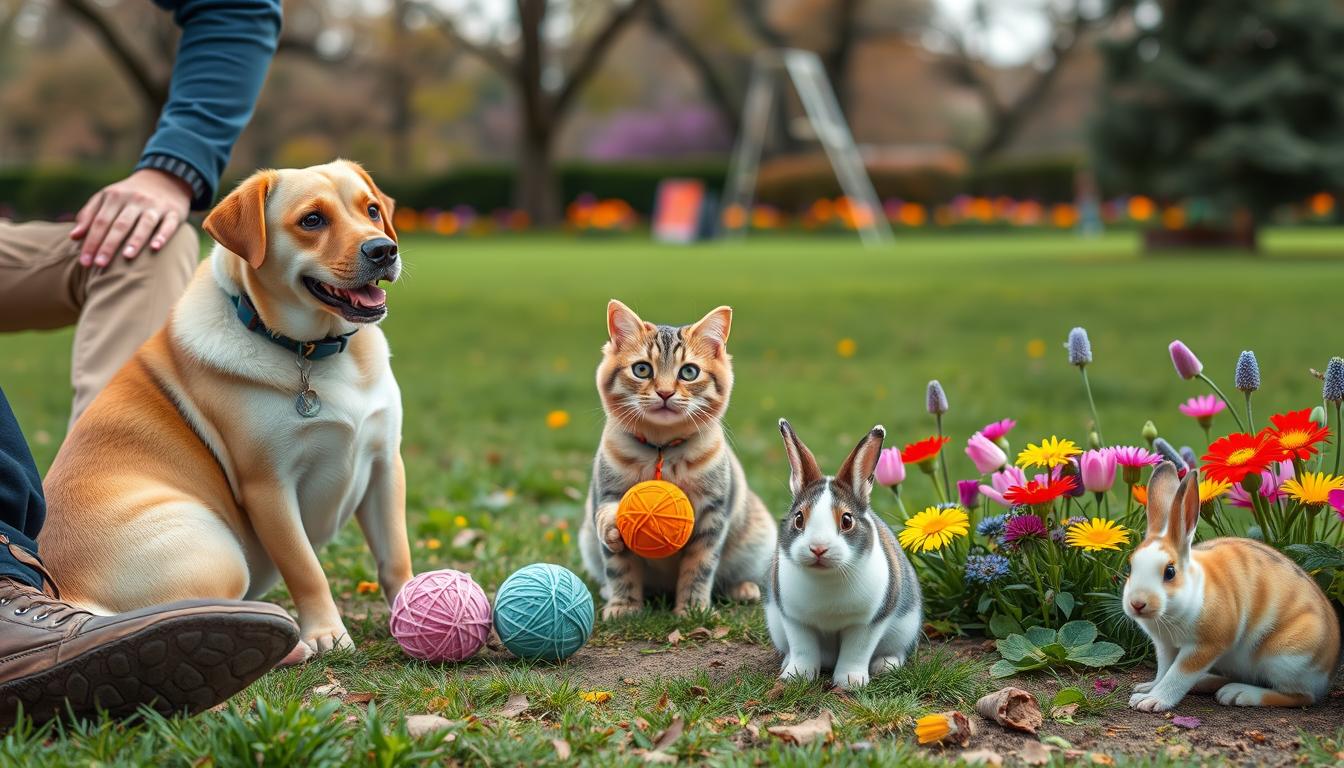Being a devoted pet owner brings great joy. In this guide, I’ll share pet behavior training tips. These will help you raise happy, obedient pets.
Whether you have a lively pup or a playful cat, we’ll cover it all. You’ll learn how to use positive reinforcement and consistency. This will strengthen your bond and make your home a peaceful place.
Understanding Your Pet’s Behavior
Effective pet behavior training starts with understanding your furry friend’s natural tendencies and communication signals. By closely observing your pet’s body language and identifying potential triggers, you can gain valuable insights. This helps tailor your training approach and build a stronger bond.
Observing Body Language
Our pets have a rich vocabulary expressed through their body language. Pay close attention to your pet’s posture, facial expressions, and movement patterns. Is their tail wagging enthusiastically or tucked between their legs? Are their ears perked up or pressed back? These subtle cues can reveal your pet’s emotional state and help you anticipate their behavior.
Identifying Triggers
Certain situations, sounds, or stimuli can trigger specific behaviors in your pet. For example, some dogs may become anxious when encountering strangers or loud noises. Cats may become agitated by sudden movements or the presence of other pets. Identifying these triggers can empower you to create a more comfortable environment for your pet and prevent unwanted behaviors.
By understanding your pet’s body language and behavior triggers, you’ll be better equipped to understand animal behavior. This allows you to develop a tailored training plan that addresses your pet’s unique needs. With patience and consistency, you can help your furry friend become a happy, well-adjusted companion.
Positive Reinforcement Techniques

Positive reinforcement is a great way to train pets. It uses rewards to teach good behavior. This method makes pets happy and well-trained, strengthening the bond between them and their owners.
Using treats and praise is a key part of positive reinforcement. When your pet does something good, like sitting, give them a treat and praise them. This tells them what actions are rewarded, helping them learn good behavior.
- Use small, bite-sized treats that your pet finds irresistible.
- Combine treats with plenty of verbal praise, petting, and affection.
- Be consistent and patient – it may take time for your pet to learn new behaviors.
Clicker training is another effective method. A clicker makes a sound when pressed, marking the moment your pet does something right. Then, give them a treat to reinforce the action. Clicker training helps pets understand what you want, making learning faster and easier.
Positive reinforcement training is a kind and effective way to teach pets. It rewards good behavior, strengthening the bond and making pets happy and well-behaved. With patience and consistency, your pet will learn quickly and follow your guidance eagerly.
Creating a Consistent Routine

Having a regular pet training routine is key for your pet’s happiness and your home’s peace. A structured setting helps your pet grow well and fit into your family. Consistency is the main secret to successful pet training.
Establishing Rules and Boundaries
It’s important to set clear rules for your pet. First, decide what behaviors you want and don’t want. Use positive ways to show your pet what’s right.
- Choose spots in your home where your pet can and can’t go.
- Make a daily plan for meals, play, and rest.
- Always praise your pet for good behavior.
Creating a routine and clear rules makes your pet feel safe and understood. This leads to a happy home and a strong bond with your pet.
| Consistent Pet Routine | Benefits |
|---|---|
| Regular feeding times | Prevents food-related behavioral issues |
| Scheduled playtime and exercise | Promotes physical and mental stimulation |
| Consistent bedtime and wake-up schedule | Supports a healthy sleep-wake cycle |
Starting a consistent pet training routine needs time and patience. But, the benefits are huge. Clear rules and a structured home make your pet happy, secure, and ready to be a valued family member.
Pet Behavior Training: Addressing Specific Issues

As a pet owner, you might face certain behavioral challenges. I’ll guide you on how to tackle common pet behavior problems. This will help you overcome obstacles and enjoy a better relationship with your pet.
Excessive Barking
Excessive barking can be a problem for you and your neighbors. Here are some techniques to help:
- Find out why your pet is barking, like boredom or needing attention.
- Teach your pet the “quiet” command and reward them for it.
- Make sure your pet gets enough exercise and mental stimulation to reduce barking.
Jumping Up
Jumping up might seem like affection, but it can be a problem. Here’s how to stop it:
- Teach your pet the “off” or “down” command and reward them when they’re calm.
- Ignore your pet when they jump up. Only give them attention when they’re calm.
- Give your pet enough exercise and playtime to keep them from jumping up.
Separation Anxiety
Separation anxiety can cause problems when you leave your pet alone. Here’s how to help:
- Start by leaving your pet alone for short periods and gradually increase the time.
- Give your pet engaging toys and activities to keep them busy when you’re away.
- Consider daycare or a pet sitter to keep your pet company when you’re not home.
Every pet is different, so you might need to tailor your approach. By using these techniques and working with your pet, you can solve behavioral issues. This will make your pet happier and more well-behaved.
| Behavioral Issue | Recommended Techniques |
|---|---|
| Excessive Barking |
|
| Jumping Up |
|
| Separation Anxiety |
|
The Importance of Patience and Consistency
Changing your pet’s behavior takes time, patience, and consistency. Starting this journey, keep a positive and encouraging attitude. Your pet’s progress might not be fast, but with dedication, you’ll see big changes.
Celebrating Small Victories
It’s key to celebrate your pet’s small wins. Every milestone shows the hard work you both do. When your pet does something new or stops a bad habit, praise them.
This praise strengthens your bond and helps them learn good habits. Consistent training leads to lasting changes. Stay patient and persistent for a happier home. Enjoy the journey, celebrate the small wins, and be proud of your progress.

